How to Restrain Regulatory Capture and Promote Green Innovation in China. An Analysis Based on Evolutionary Game Theory
Abstract
:1. Introduction
2. Literature Review
2.1. The Development of Regulatory Capture Theory
2.2. The Affecting Factors of Regulatory Capture
2.3. The Affecting Factors of GI
2.4. Evolutionary Game Theory in Environmental Governance
2.5. Toward and Analytical Framework
3. Research Method
3.1. Main Assumptions and Variables
3.2. Analysis of Evolutionary Stability Strategy under Media Participation
3.2.1. Evolutionary Process
3.2.2. Evolutionary Equilibrium Stability Analysis
3.3. Simulation
4. Results
4.1. Initial Game Strategy
4.2. The Impacts of Policy Burdens on Environmental Governance
4.3. The Impacts of Media on Environmental Governance
4.4. Comparison of Media’s and Policy Burden’s Effects
5. Conclusions and Implications
5.1. Conclusions
5.2. Implication for Theory and Practice
Funding
Institutional Review Board Statement
Informed Consent Statement
Conflicts of Interest
References
- Sachs, J.; Schmidt-Traub, G.; Kroll, C.; Lafortune, G.; Fuller, G.; Woelm, F. Sustainable Development Report 2020: The Sustainable Development Goals and COVID-19 Includes the SDG Index and Dashboards; Cambridge University Press: Cambridge, UK, 2021. [Google Scholar]
- Tang, J.; Wang, Q.; Choi, G. Efficiency assessment of industrial solid waste generation and treatment processes with carry-over in China. Sci. Total Environ. 2020, 726, 138274. [Google Scholar] [CrossRef] [PubMed]
- Hu, S.; Zeng, G.; Cao, X.; Yuan, H.; Chen, B. Does Technological Innovation Promote Green Development? A Case Study of the Yangtze River Economic Belt in China. Int. J. Environ. Res. Public Health 2021, 18, 6111. [Google Scholar] [CrossRef]
- Fischer-Kowalski, M.; Swilling, M.; Von Weizsacker, E.U.; Ren, Y.; Moriguchi, Y.; Crane, W.; Krausmann, F.K.; Eisenmenger, N.; Giljum, S.; Hennicke, P.; et al. Decoupling: Natural Resource use and Environmental Impacts from Economic Growth; Technical Report; United Nations Environment Programme: Nairobi, Kenya, 2011. [Google Scholar]
- Li, D.; Zeng, T. Are China’s intensive pollution industries greening? An analysis based on green innovation efficiency. J. Clean. Prod. 2020, 259, 120901. [Google Scholar] [CrossRef]
- Chen, X.; Yi, N.; Zhang, L.; Li, D. Does institutional pressure foster corporate green innovation? Evidence from China’s top 100 companies. J. Clean. Prod. 2018, 188, 304–311. [Google Scholar] [CrossRef]
- Stigler, G.J. The theory of economic regulation. Bell J. Econ. Manag. Sci. 1971, 2, 3–21. [Google Scholar] [CrossRef]
- Dal Bó, E. Regulatory capture: A review. Oxf. Rev. Econ. Policy 2006, 22, 203–225. [Google Scholar] [CrossRef]
- Sigman, H. Transboundary spillovers and decentralization of environmental policies. J. Environ. Econ. Manag. 2005, 50, 82–101. [Google Scholar] [CrossRef] [Green Version]
- Wu, H.; Hao, Y.; Ren, S. How do environmental regulation and environmental decentralization affect green total factor energy efficiency: Evidence from China. Energy Econ. 2020, 91, 104880. [Google Scholar] [CrossRef]
- Gong, Q.; Lei, L.; Yuan, Y. Policy burden, regulation capture and food safety. Econ. Res. J 2015, 8, 4–15. [Google Scholar]
- Zhou, L.A. Governing China’s Local Officials: An Analysis of Promotion Tournament Model. Econ. Res. J. 2007, 7, 36–50. [Google Scholar]
- Li, H.; Zhou, L.A. Political turnover and economic performance: The incentive role of personnel control in China. J. Public Econ. 2005, 89, 1743–1762. [Google Scholar] [CrossRef]
- Laffont, J.J.; Martimort, D. Transaction costs, institutional design and the separation of powers. Eur. Econ. Rev. 1998, 42, 673–684. [Google Scholar] [CrossRef]
- Downs, A. An economic theory of political action in a democracy. J. Political Econ. 1957, 65, 135–150. [Google Scholar] [CrossRef]
- Posner, R. Theories of Economic Regulation. Bell J. Econ. 1974, 5, 335–358. [Google Scholar] [CrossRef] [Green Version]
- Peltzman, S. Toward a more general theory of regulation. J. Law Econ. 1976, 19, 211–240. [Google Scholar] [CrossRef]
- Laffont, J.J.; Tirole, J. The politics of government decision-making: A theory of regulatory capture. Q. J. Econ. 1991, 106, 1089–1127. [Google Scholar] [CrossRef]
- Lin, J.Y.; Li, Z. Policy burden, privatization and soft budget constraint. J. Comp. Econ. 2008, 36, 90–102. [Google Scholar] [CrossRef]
- Shen, F.; Liu, B.; Luo, F.; Wu, C.; Chen, H.; Wei, W. The effect of economic growth target constraints on green technology innovation. J. Environ. Manag. 2021, 292, 112765. [Google Scholar] [CrossRef] [PubMed]
- KORNAI*, J. The soft budget constraint. Kyklos 1986, 39, 3–30. [Google Scholar] [CrossRef]
- Feng, Y.; Wang, X.; Hu, S. Accountability audit of natural resource, air pollution reduction and political promotion in China: Empirical evidence from a quasi-natural experiment. J. Clean. Prod. 2020, 287, 125002. [Google Scholar] [CrossRef]
- Wu, M.; Cao, X. Greening the career incentive structure for local officials in China: Does less pollution increase the chances of promotion for Chinese local leaders? J. Environ. Econ. Manag. 2021, 107, 102440. [Google Scholar] [CrossRef]
- Laffont, J.J.; Meleu, M. Reciprocal supervision, collusion and organizational design. Scand. J. Econ. 1997, 99, 519–540. [Google Scholar] [CrossRef]
- Fremeth, A.R.; Holburn, G.L. Information asymmetries and regulatory decision costs: An analysis of US electric utility rate changes 1980–2000. J. Law Econ. Organ. 2012, 28, 127–162. [Google Scholar] [CrossRef]
- Gong, Q.; Zhang, Y.; Yu, J. Incentives, information and food safety regulation. Econ. Res. J. 2013, 3, 135–147. [Google Scholar]
- Gao, S.; Ling, S.; Liu, W. The role of social media in promoting information disclosure on environmental incidents: An evolutionary game theory perspective. Sustainability 2018, 10, 4372. [Google Scholar] [CrossRef] [Green Version]
- Grafton, R.Q.; Williams, J. Rent-seeking behaviour and regulatory capture in the Murray-Darling Basin, Australia. Int. J. Water Resour. Dev. 2020, 36, 484–504. [Google Scholar] [CrossRef]
- Castellacci, F.; Lie, C.M. A taxonomy of green innovators: Empirical evidence from South Korea. J. Clean. Prod. 2017, 143, 1036–1047. [Google Scholar] [CrossRef] [Green Version]
- Luo, Q.; Miao, C.; Sun, L.; Meng, X.; Duan, M. Efficiency evaluation of green technology innovation of China’s strategic emerging industries: An empirical analysis based on Malmquist-data envelopment analysis index. J. Clean. Prod. 2019, 238, 117782. [Google Scholar] [CrossRef]
- Yin, S.; Zhang, N.; Li, B. Enhancing the competitiveness of multi-agent cooperation for green manufacturing in China: An empirical study of the measure of green technology innovation capabilities and their influencing factors. Sustain. Prod. Consum. 2020, 23, 63–76. [Google Scholar] [CrossRef]
- Wakeford, J.J.; Gebreeyesus, M.; Ginbo, T.; Yimer, K.; Manzambi, O.; Okereke, C.; Black, M.; Mulugetta, Y. Innovation for green industrialisation: An empirical assessment of innovation in Ethiopia’s cement, leather and textile sectors. J. Clean. Prod. 2017, 166, 503–511. [Google Scholar] [CrossRef]
- Arena, C.; Michelon, G.; Trojanowski, G. Big egos can be green: A study of CEO hubris and environmental innovation. Br. J. Manag. 2018, 29, 316–336. [Google Scholar] [CrossRef]
- Burki, U.; Dahlstrom, R. Mediating effects of green innovations on interfirm cooperation. Australas. Mark. J. (AMJ) 2017, 25, 149–156. [Google Scholar] [CrossRef]
- Ebrahimi, P.; Mirbargkar, S.M. Green entrepreneurship and green innovation for SME development in market turbulence. Eurasian Bus. Rev. 2017, 7, 203–228. [Google Scholar] [CrossRef]
- Dangelico, R.M. Green product innovation: Where we are and where we are going. Bus. Strategy Environ. 2016, 25, 560–576. [Google Scholar] [CrossRef]
- Roy, M.; Khastagir, D. Exploring role of green management in enhancing organizational efficiency in petro-chemical industry in India. J. Clean. Prod. 2016, 121, 109–115. [Google Scholar] [CrossRef]
- Stanovcic, T.; Pekovic, S.; Bouziri, A. The effect of knowledge management on environmental innovation: The empirical evidence from France. Balt. J. Manag. 2015, 10, 413–431. [Google Scholar] [CrossRef]
- Su, Y.; Yu, Y.Q. Spatial agglomeration of new energy industries on the performance of regional pollution control through spatial econometric analysis. Sci. Total Environ. 2020, 704, 135261. [Google Scholar] [CrossRef] [PubMed]
- Li, D.; Zheng, M.; Cao, C.; Chen, X.; Ren, S.; Huang, M. The impact of legitimacy pressure and corporate profitability on green innovation: Evidence from China top 100. J. Clean. Prod. 2017, 141, 41–49. [Google Scholar] [CrossRef] [Green Version]
- Martínez-Ros, E.; Kunapatarawong, R. Green innovation and knowledge: The role of size. Bus. Strategy Environ. 2019, 28, 1045–1059. [Google Scholar] [CrossRef]
- Wong, S.K.S. Environmental requirements, knowledge sharing and green innovation: Empirical evidence from the electronics industry in China. Bus. Strategy Environ. 2013, 22, 321–338. [Google Scholar] [CrossRef]
- Su, Y.; Jiang, X.; Lin, Z. Simulation and Relationship Strength: Characteristics of Knowledge Flows Among Subjects in a Regional Innovation System. Sci. Technol. Soc. 2021. [Google Scholar] [CrossRef]
- Braun, E.; Wield, D. Regulation as a means for the social control of technology. Technol. Anal. Strateg. Manag. 1994, 6, 259–272. [Google Scholar] [CrossRef]
- Lin, H.; Zeng, S.; Ma, H.; Qi, G.; Tam, V.W. Can political capital drive corporate green innovation? Lessons from China. J. Clean. Prod. 2014, 64, 63–72. [Google Scholar] [CrossRef]
- Chiou, T.Y.; Chan, H.K.; Lettice, F.; Chung, S.H. The influence of greening the suppliers and green innovation on environmental performance and competitive advantage in Taiwan. Transp. Res. Part E Logist. Transp. Rev. 2011, 47, 822–836. [Google Scholar] [CrossRef]
- Li, Z.; Liao, G.; Wang, Z.; Huang, Z. Green loan and subsidy for promoting clean production innovation. J. Clean. Prod. 2018, 187, 421–431. [Google Scholar] [CrossRef]
- Xu, X.; Zhang, W.; Wang, T.; Xu, Y.; Du, H. Impact of subsidies on innovations of environmental protection and circular economy in China. J. Environ. Manag. 2021, 289, 112385. [Google Scholar] [CrossRef]
- Porter, M.E.; Van der Linde, C. Toward a new conception of the environment-competitiveness relationship. J. Econ. Perspect. 1995, 9, 97–118. [Google Scholar] [CrossRef]
- Hamamoto, M. Environmental regulation and the productivity of Japanese manufacturing industries. Resour. Energy Econ. 2006, 28, 299–312. [Google Scholar] [CrossRef]
- Lanoie, P.; Patry, M.; Lajeunesse, R. Environmental regulation and productivity: Testing the porter hypothesis. J. Prod. Anal. 2008, 30, 121–128. [Google Scholar] [CrossRef]
- Rubashkina, Y.; Galeotti, M.; Verdolini, E. Environmental regulation and competitiveness: Empirical evidence on the Porter Hypothesis from European manufacturing sectors. Energy Policy 2015, 83, 288–300. [Google Scholar] [CrossRef] [Green Version]
- Albrizio, S.; Kozluk, T.; Zipperer, V. Environmental policies and productivity growth: Evidence across industries and firms. J. Environ. Econ. Manag. 2017, 81, 209–226. [Google Scholar] [CrossRef]
- Cardell, J.B.; Hitt, C.C.; Hogan, W.W. Market power and strategic interaction in electricity networks. Resour. Energy Econ. 1997, 19, 109–137. [Google Scholar] [CrossRef]
- Leyton-Brown, K.; Shoham, Y. Essentials of game theory: A concise multidisciplinary introduction. Synth. Lect. Artif. Intell. Mach. Learn. 2008, 2, 1–88. [Google Scholar] [CrossRef] [Green Version]
- Nagarajan, M.; Sošić, G. Game-theoretic analysis of cooperation among supply chain agents: Review and extensions. Eur. J. Oper. Res. 2008, 187, 719–745. [Google Scholar] [CrossRef]
- Taylor, P.D.; Jonker, L.B. Evolutionary stable strategies and game dynamics. Math. Biosci. 1978, 40, 145–156. [Google Scholar] [CrossRef]
- Smith, J.M.; Price, G.R. The logic of animal conflict. Nature 1973, 246, 15–18. [Google Scholar] [CrossRef]
- Wang, H.; Cai, L.; Zeng, W. Research on the evolutionary game of environmental pollution in system dynamics model. J. Exp. Theor. Artif. Intell. 2011, 23, 39–50. [Google Scholar] [CrossRef]
- Zhang, S.; Yu, Y.; Zhu, Q.; Qiu, C.M.; Tian, A. Green innovation mode under carbon tax and innovation subsidy: An evolutionary game analysis for portfolio policies. Sustainability 2020, 12, 1385. [Google Scholar] [CrossRef] [Green Version]
- Zhao, X.; Bai, X. How to motivate the producers’ green innovation in WEEE recycling in China?–An analysis based on evolutionary game theory. Waste Manag. 2021, 122, 26–35. [Google Scholar] [CrossRef]
- Sheng, J.; Zhou, W.; Zhu, B. The coordination of stakeholder interests in environmental regulation: Lessons from China’s environmental regulation policies from the perspective of the evolutionary game theory. J. Clean. Prod. 2020, 249, 119385. [Google Scholar] [CrossRef]
- Chen, Y.; Zhang, J.; Tadikamalla, P.R.; Gao, X. The relationship among government, enterprise, and public in environmental governance from the perspective of multi-player evolutionary game. Int. J. Environ. Res. Public Health 2019, 16, 3351. [Google Scholar] [CrossRef] [Green Version]
- Xu, R.; Wang, Y.; Wang, W.; Ding, Y. Evolutionary game analysis for third-party governance of environmental pollution. J. Ambient Intell. Humaniz. Comput. 2019, 10, 3143–3154. [Google Scholar] [CrossRef]
- Cherry, T.L.; Kallbekken, S.; Kroll, S. The acceptability of efficiency-enhancing environmental taxes, subsidies and regulation: An experimental investigation. Environ. Sci. Policy 2012, 16, 90–96. [Google Scholar] [CrossRef] [Green Version]
- Kölbel, J.F.; Busch, T.; Jancso, L.M. How media coverage of corporate social irresponsibility increases financial risk. Strateg. Manag. J. 2017, 38, 2266–2284. [Google Scholar] [CrossRef]
- Gsottbauer, E.; Van den Bergh, J.C. Environmental policy theory given bounded rationality and other-regarding preferences. Environ. Resour. Econ. 2011, 49, 263–304. [Google Scholar] [CrossRef] [Green Version]
- Zhu, Q.H.; Dou, Y.J. Evolutionary game model between governments and core enterprises in greening supply chains. Syst. Eng.-Theory Pract. 2007, 27, 85–89. [Google Scholar] [CrossRef]
- Chen, J.; Hua, C.; Liu, C. Considerations for better construction and demolition waste management: Identifying the decision behaviors of contractors and government departments through a game theory decision-making model. J. Clean. Prod. 2019, 212, 190–199. [Google Scholar] [CrossRef]
- Chen, W.; Hu, Z.H. Using evolutionary game theory to study governments and manufacturers’ behavioral strategies under various carbon taxes and subsidies. J. Clean. Prod. 2018, 201, 123–141. [Google Scholar] [CrossRef]
- Du, L.; Feng, Y.; Lu, W.; Kong, L.; Yang, Z. Evolutionary game analysis of stakeholders’ decision-making behaviours in construction and demolition waste management. Environ. Impact Assess. Rev. 2020, 84, 106408. [Google Scholar] [CrossRef]
- Friedman, D. Evolutionary games in economics. Econometrica 1991, 59, 637–666. [Google Scholar] [CrossRef] [Green Version]
- Audretsch, D.B.; Feldman, M.P. Innovative clusters and the industry life cycle. Rev. Ind. Organ. 1996, 11, 253–273. [Google Scholar] [CrossRef]
- Tavassoli, S. Innovation determinants over industry life cycle. Technol. Forecast. Soc. Chang. 2015, 91, 18–32. [Google Scholar] [CrossRef] [Green Version]
- Xiang, X.; Liu, C.; Yang, M.; Zhao, X. Confession or justification: The effects of environmental disclosure on corporate green innovation in China. Corp. Soc. Responsib. Environ. Manag. 2020, 27, 2735–2750. [Google Scholar] [CrossRef]
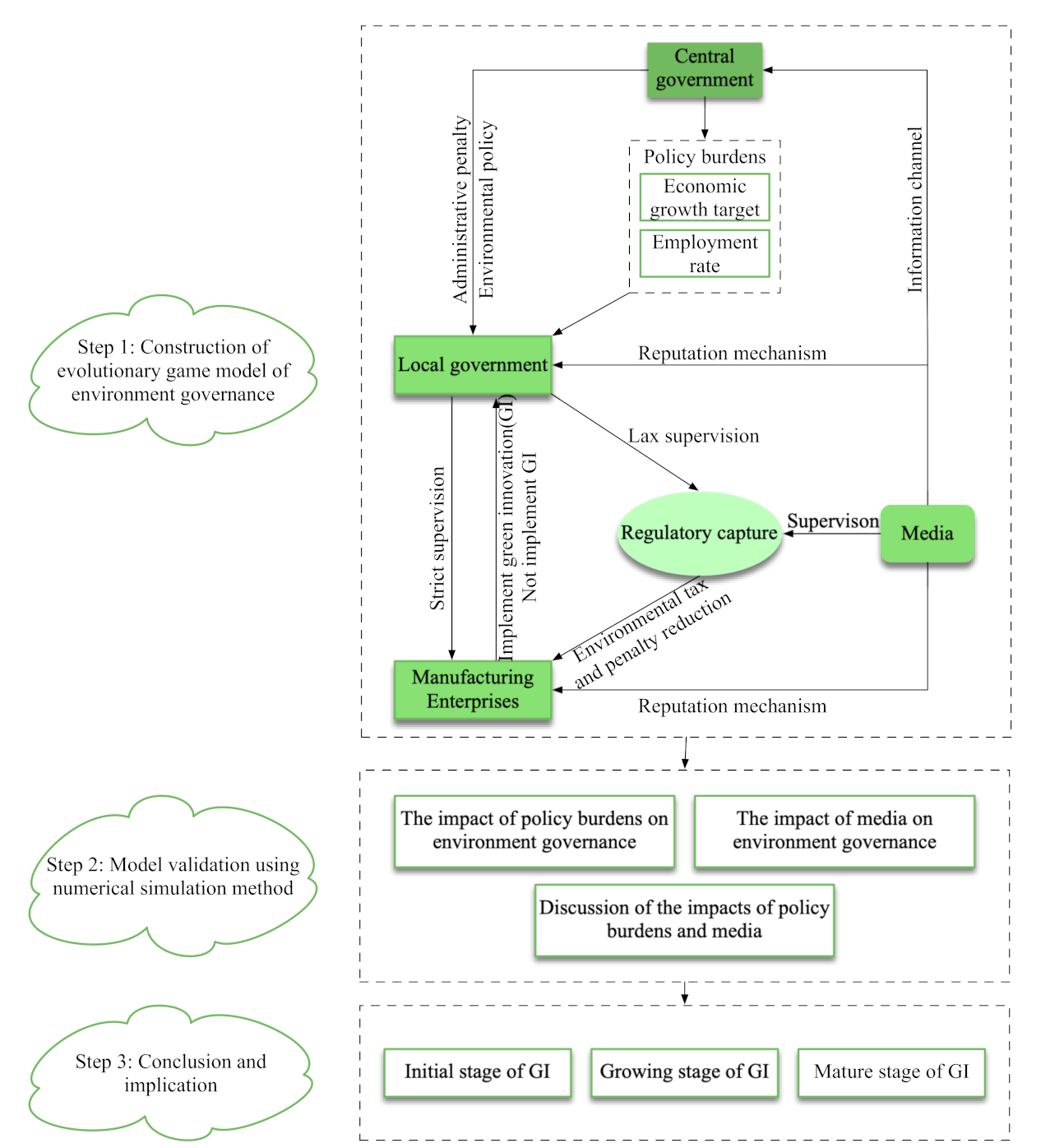
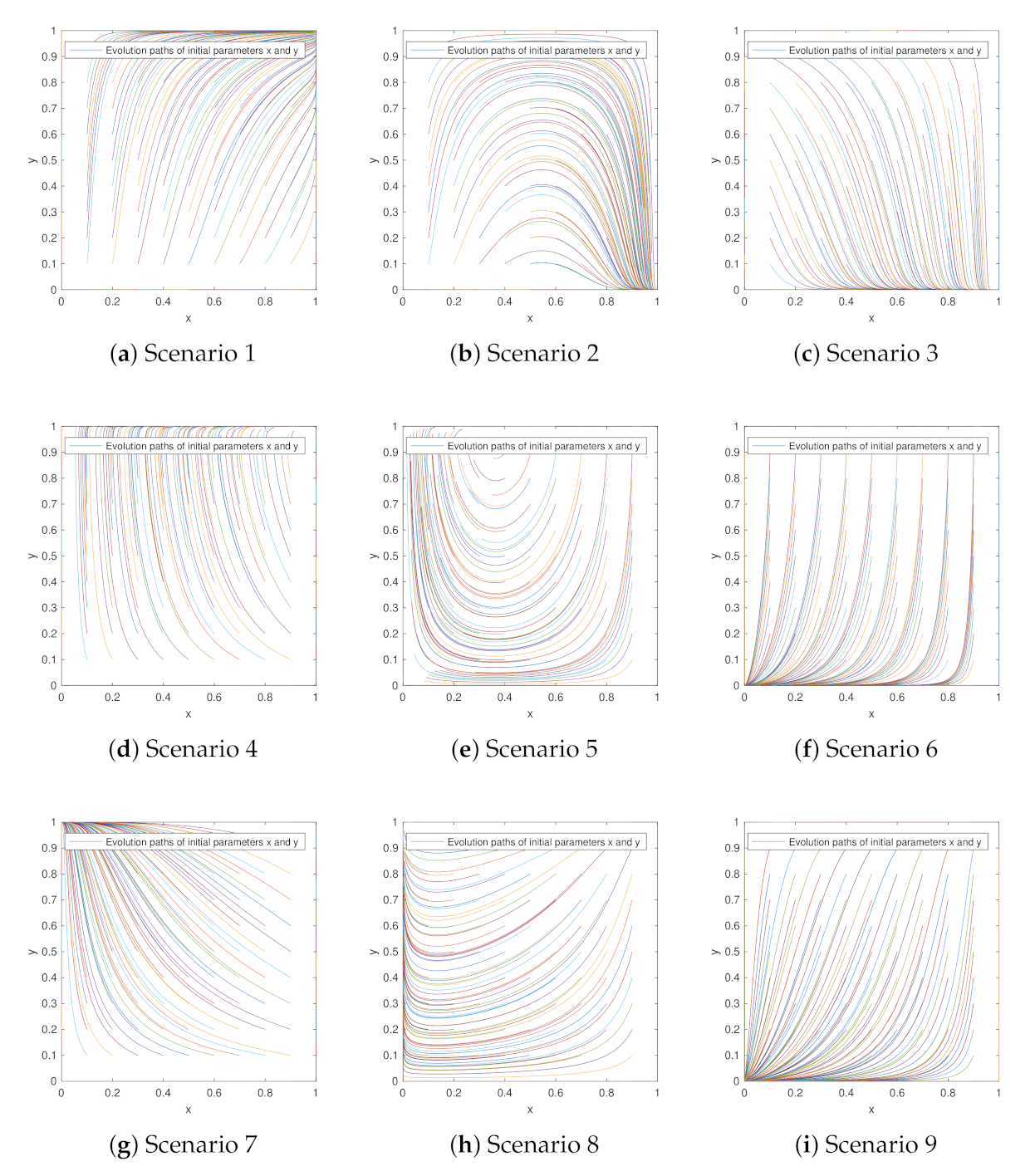
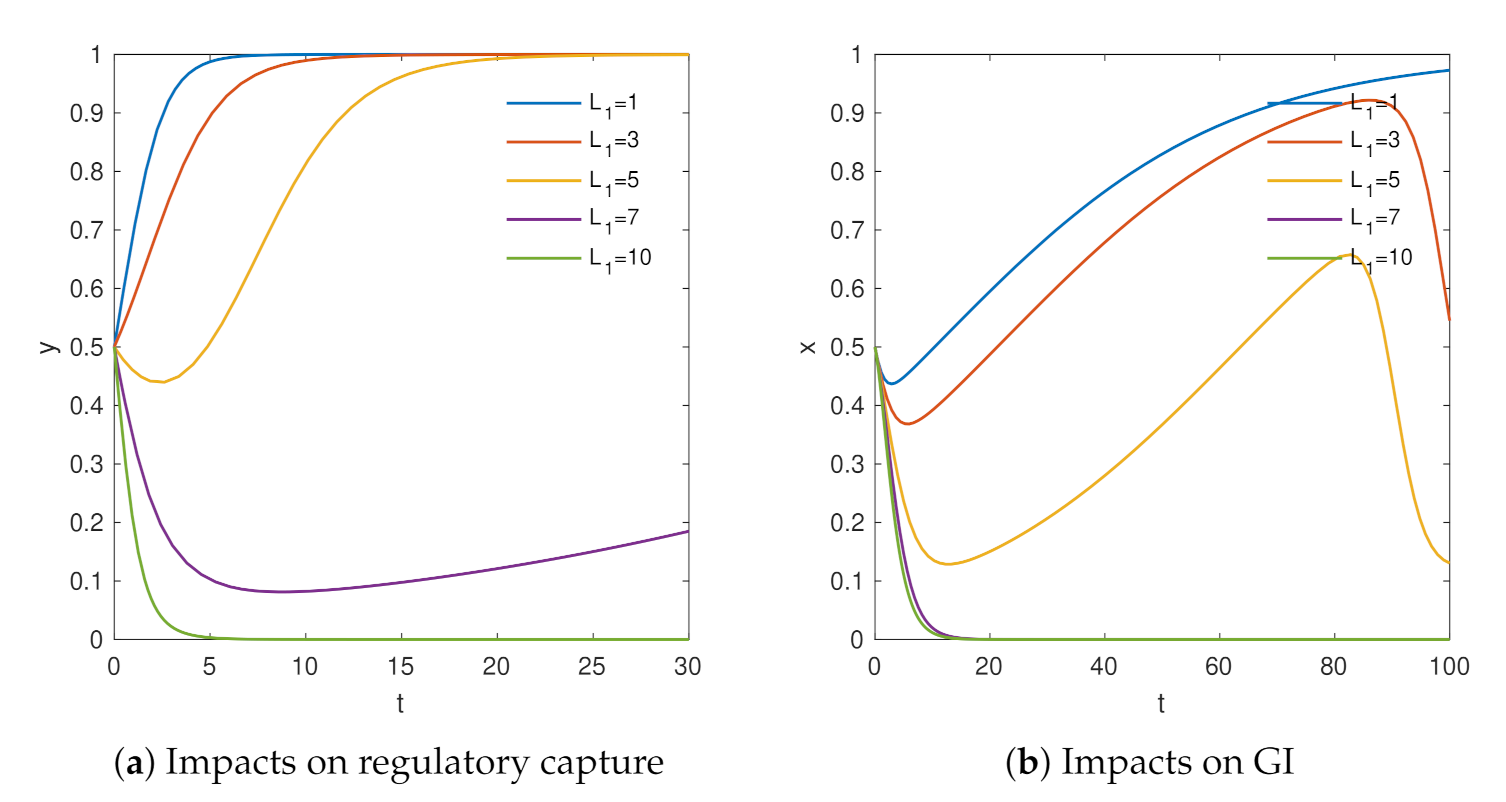
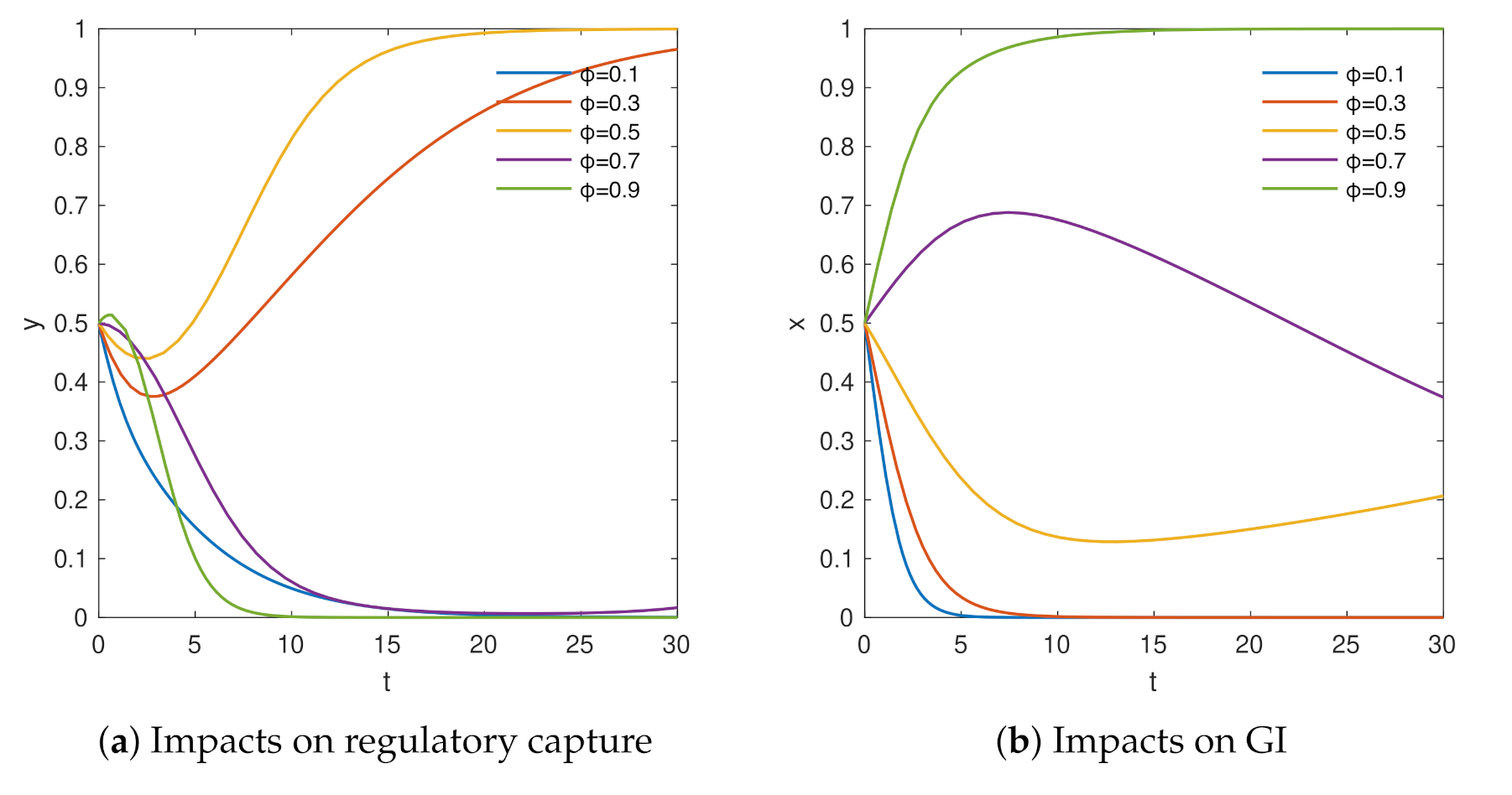

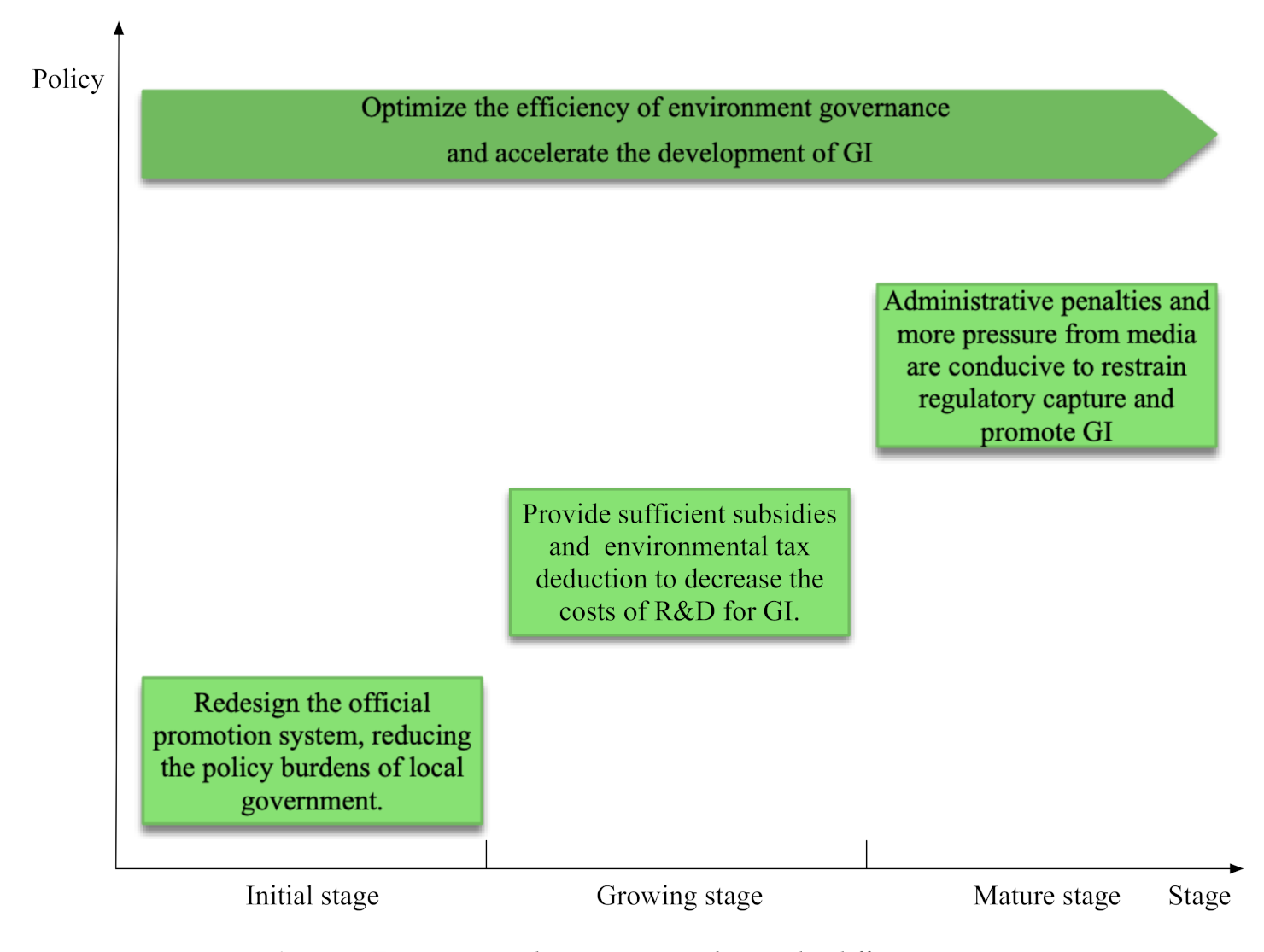
| Variable | Description | References |
|---|---|---|
| the revenue of maintaining original production | Zhao and Bai [61] | |
| the penalty per unit of pollutants | ZHU and DOU [68] | |
| the profit of the manufacturing enterprises’ reputation | Gao et al. [27] | |
| the penalty from central government | Gao et al. [27] | |
| the cost of government’s supervision | ZHU and DOU [68] | |
| expenditures per unit of reduced pollutants | Zhao and Bai [61] | |
| the cost of government’s supervision with media participation | Gao et al. [27] | |
| t | the environmental tax per unit of the pollutants | Chen and Hu [70] |
| the lose of the local economy | Chen et al. [63] | |
| the probability for the local government of finding manufacturing | Du et al. [71] | |
| enterprises not implement green innovation(GI) | ||
| the loss of manufacturing enterprises’ reputation | Gao et al. [27] | |
| the ratio of environmental tax reduction | Cherry et al. [65] | |
| the loss of the local government’s reputation | Gao et al. [27] | |
| the probability for media of finding regulatory capture | Gao et al. [27] |
| Manufacturing Enterprises | The Local Government | |
|---|---|---|
| Strict Supervision | Lax Supervision | |
| Implement GI | ||
| Not Implement GI |
| Scenario 1 | Scenario 2 | Scenario 3 | |||||||
|---|---|---|---|---|---|---|---|---|---|
| Results | Results | Results | |||||||
| (0,0) | + | + | Unstable | + | + | Unstable | − | N | Saddle point |
| (0,1) | − | N | Saddle point | − | N | Saddle point | + | + | Unstable |
| (1,0) | − | N | Saddle point | + | − | ESS | + | − | ESS |
| (1,1) | + | − | ESS | − | N | Saddle point | − | N | Saddle point |
| Scenario 4 | Scenario 5 | Scenario 6 | |||||||
|---|---|---|---|---|---|---|---|---|---|
| Results | Results | Results | |||||||
| (0,0) | − | N | Saddle point | − | N | Saddle point | + | − | ESS |
| (0,1) | − | N | Saddle point | − | N | Saddle point | + | + | Unstable |
| (1,0) | + | + | Unstable | − | N | Saddle point | − | N | Saddle point |
| (1,1) | + | − | ESS | − | N | Saddle point | − | N | Saddle point |
| Scenario 7 | Scenario 8 | Scenario 9 | |||||||
|---|---|---|---|---|---|---|---|---|---|
| Results | Results | Results | |||||||
| (0,0) | − | N | Saddle point | − | N | Saddle point | + | − | ESS |
| (0,1) | + | − | ESS | + | − | ESS | − | N | Saddle point |
| (1,0) | + | + | Unstable | − | N | Saddle point | − | N | Saddle point |
| (1,1) | − | N | Saddle point | + | + | Unstable | + | + | Unstable |
| Variable | Q | q | t | |||||||||||
|---|---|---|---|---|---|---|---|---|---|---|---|---|---|---|
| Value | 10 | 1 | 0.1 | 1 | 1 | 1.5 | 0.5 | 1 | 1 | 6 | 2 | 0.6 | 0.75 | 0.1 |
| Variables | Value Range | Variables | Value Range |
|---|---|---|---|
| low level | low level | ||
| Middle level | Middle level | ||
| High level | High level |
Publisher’s Note: MDPI stays neutral with regard to jurisdictional claims in published maps and institutional affiliations. |
© 2021 by the author. Licensee MDPI, Basel, Switzerland. This article is an open access article distributed under the terms and conditions of the Creative Commons Attribution (CC BY) license (https://creativecommons.org/licenses/by/4.0/).
Share and Cite
Yuan, Q. How to Restrain Regulatory Capture and Promote Green Innovation in China. An Analysis Based on Evolutionary Game Theory. Sustainability 2021, 13, 9752. https://doi.org/10.3390/su13179752
Yuan Q. How to Restrain Regulatory Capture and Promote Green Innovation in China. An Analysis Based on Evolutionary Game Theory. Sustainability. 2021; 13(17):9752. https://doi.org/10.3390/su13179752
Chicago/Turabian StyleYuan, Qiezeng. 2021. "How to Restrain Regulatory Capture and Promote Green Innovation in China. An Analysis Based on Evolutionary Game Theory" Sustainability 13, no. 17: 9752. https://doi.org/10.3390/su13179752
APA StyleYuan, Q. (2021). How to Restrain Regulatory Capture and Promote Green Innovation in China. An Analysis Based on Evolutionary Game Theory. Sustainability, 13(17), 9752. https://doi.org/10.3390/su13179752






